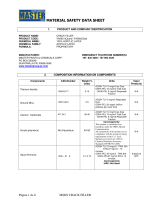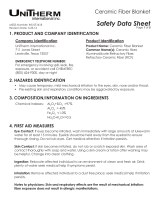Page is loading ...

Cements
MATERIAL SAFETY DATA SHEET
(Complies with OSHA 29 CFR 1910.1200)
SECTION I: PRODUCT IDENTIFICATION
The QUIKRETE
®
Companies Emergency Telephone Number
One Securities Centre (770) 216-9580
3490 Piedmont Road, Suite 1300
Atlanta, GA 30329 Information Telephone Number
(770) 216-9580
MSDS K1
Revision: Feb-10
QUIKRETE
®
Product Name Code #
QUIKRETE
®
PORTLAND CEMENT 1124
PORTLAND/POZZOLAN CEMENT 1118-35
QUIKRETE
®
PORTLAND T-III CEMENT 2126-53
PRODUCT USE: HYDRAULIC CEMENTS FOR GENERAL CONSTRUCTION AND REPAIR
SECTION II - HAZARD IDENTIFICATION
Route(s) of Entry: Inhalation, Skin, Ingestion
Acute Exposure: Product becomes alkaline when exposed to moisture. Exposure can dry the skin,
cause alkali burns and affect the mucous membranes. Dust can irritate the eyes and upper
respiratory system. Toxic effects noted in animals include, for acute exposures, alveolar damage
with pulmonary edema.
Chronic Exposure: Dust can cause inflammation of the lining tissue of the interior of the nose and
inflammation of the cornea. Hypersensitive individuals may develop an allergic dermatitis.
Carcinogenicity: Since Portland cement and blended cements are manufactured from raw
materials mined from the earth (limestone, marl, sand, shale, etc.) and process heat is provided by
burning fossil fuels, trace, but detectable, amounts of naturally occurring, and possibly harmful,
elements may be found during chemical analysis. Under ASTM standards, Portland cement may
contain 0.75 % insoluble residue. A fraction of these residues may be free crystalline silica.
Respirable crystalline silica (quartz) can cause silicosis, a fibrosis (scarring) of the lungs and
possibly cancer. There is evidence that exposure to respirable silica or the disease silicosis is
associated with an increased incidence of Scleroderma, tuberculosis and kidney disorders.
Carcinogenicity Listings: NTP: Known carcinogen
OSHA: Not listed as a carcinogen

IARC Monographs: Group 1 Carcinogen
California Proposition 65: Known carcinogen
NTP:
The National Toxicology Program, in its “Ninth Report on Carcinogens” (released May 15,
2000) concluded that “Respirable crystalline silica (RCS), primarily quartz dusts occurring in
industrial and occupational settings, is known to be a human carcinogen, based on sufficient
evidence of carcinogenicity from studies in humans indicating a causal relationship between
exposure to RCS and increased lung cancer rates in workers exposed to crystalline silica dust
(reviewed in IAC, 1997; Brown et al., 1997; Hind et al., 1997)
IARC:
The International Agency for Research on Cancer (“IARC”) concluded that there was
“sufficient evidence in humans for the carcinogenicity of crystalline silica in the forms of quartz or
cristobalite from occupational sources”, and that there is “sufficient evidence in experimental
animals for the carcinogenicity of quartz or cristobalite.” The overall IARC evaluation was that
“crystalline silica inhaled in the form of quartz or cristobalite from occupational sources is
carcinogenic to humans (Group 1).” The IARC evaluation noted that “carcinogenicity was not
detected in all industrial circumstances or studies. Carcinogenicity may be dependent on inherent
characteristics of the crystalline silica or on external factors affecting its biological activity or
distribution of its polymorphs.” For further information on the IARC evaluation, see IARC
Monographs on the Evaluation of carcinogenic Risks to Humans, Volume 68, “Silica, Some
Silicates.” (1997)
Signs and Symptoms of Exposure: Symptoms of excessive exposure to the dust include
shortness of breath and reduced pulmonary function. Excessive exposure to skin and eyes
especially when mixed with water can cause caustic burns as severe as third degree.
Medical Conditions Generally Aggravated by Exposure: Individuals with sensitive skin and with
pulmonary and/or respiratory disease, including, but not limited to, asthma and bronchitis, or subject
to eye irritation, should be precluded from exposure. Exposure to crystalline silica or the disease
silicosis is associated with increased incidence of scleroderma, Tuberculosis and possibly increased
incidence of kidney lesions.
Chronic Exposure: Dust can cause inflammation of the lining tissue of the interior of the nose and
inflammation of the cornea. Hypersensitive individuals may develop an allergic dermatitis. (May
contain trace (<0.05 %) amounts of chromium salts or compounds including hexavalent chromium,
or other metals found to be hazardous or toxic in some chemical forms. These metals are mostly
present as trace substitutions within the principal minerals)
Medical Conditions Generally Aggravated by Exposure: Individuals with sensitive skin and with
pulmonary and/or respiratory disease, including, but not limited to, asthma and bronchitis, or subject
to eye irritation, should be precluded from exposure.
SECTION III - HAZARDOUS INGREDIENTS/IDENTITY INFORMATION
Hazardous Components CAS No. PEL (OSHA) TLV (ACGIH)
mg/M
3
mg/M
3
Portland Cement 65997-15-1 5 5

May contain:
Silica Sand, crystalline 14808-60-7 10 0.05 (respirable)
%SiO
2
+2
Pulverized Limestone 01317-65-3 5 5
Fly Ash 68131-74-8 5 5
Gypsum 10101-41-4 5 5
Lime 01305-62-0 5 5
Although these products contain no intentionally added Silica, they may contain small amounts of
silica occurring as natural impurities in the other raw materials.
Other Limits: National Institute for Occupational Safety and Health (NIOSH). Recommended
standard maximum permissible concentration=0.05 mg/M
3
(respirable free silica) as determined by
a full-shift sample up to 10-hour working day, 40-hour work week. See NIOSH Criteria for a
Recommended Standard Occupational Exposure to Crystalline Silica.
SECTION IV – First Aid Measures
Eyes: Immediately flush eye thoroughly with water. Continue flushing eye for at least 15 minutes,
including under lids, to remove all particles. Call physician immediately.
Skin: Wash skin with cool water and pH-neutral soap or a mild detergent. Seek medical treatment if
irritation or inflammation develops or persists. Seek immediate medical treatment in the event of
burns.
Inhalation: Remove person to fresh air. If breathing is difficult, administer oxygen. If not breathing,
give artificial respiration. Seek medical help if coughing and other symptoms do not subside.
Inhalations of large amounts of Portland cement require immediate medical attention.
Ingestion: Do not induce vomiting. If conscious, have the victim drink plenty of water and call a
physician immediately.
SECTION V - FIRE AND EXPLOSION HAZARD DATA
Flammability: Noncombustible and not explosive.
Auto-ignition Temperature: Not Applicable
Flash Points: Not Applicable
SECTION VI – ACCIDENTAL RELEASE MEASURES
If spilled, use dustless methods (vacuum) and place into covered container for disposal (if not
contaminated or wet). Use adequate ventilation to keep exposure to airborne contaminants below
the exposure limit.
SECTION VII - PRECAUTIONS FOR SAFE HANDLING AND STORAGE

Do not allow water to contact the product until time of use. DO NOT BREATHE DUST. In dusty
environments, the use of an OSHA, MSHA or NIOSH approved respirator and tight fitting goggles is
recommended.
SECTION VIII – EXPOSURE CONTROL MEASURES
Engineering Controls: Local exhaust can be used, if necessary, to control airborne dust levels.
Personal Protection: The use of barrier creams or impervious gloves, boots and clothing to protect
the skin from contact is recommended. Following work, workers should shower with soap and
water. Precautions must be observed because burns occur with little warning -- little heat is sensed.
WARN EMPLOYEES AND/OR CUSTOMERS OF THE HAZARDS AND REQUIRED OSHA
PRECAUTIONS ASSOCIATED WITH THE USE OF THIS PRODUCT.
Exposure Limits: Consult local authorities for acceptable exposure limits
SECTION IX - PHYSICAL/CHEMICAL CHARACTERISTICS
Appearance: Gray to gray-brown colored powder. Some products available in white and other
colors.
Specific Gravity: 2.6 to 3.15 Melting Point: >2700
o
F
Boiling Point: >2700
o
F Vapor Pressure: Not Applicable
Vapor Density: Not Applicable Evaporation Rate: Not Applicable
Solubility in Water: Slight Odor: Not Applicable
SECTION X - REACTIVITY DATA
Stability: Stable.
Incompatibility (Materials to Avoid): Material when mixed with water will react with Aluminum and
other alkali and alkaline earth elements liberating hydrogen gas.
Hazardous Decomposition or By-products: None
Hazardous Polymerization: Will Not Occur.
Condition to Avoid: Keep dry until used to preserve product utility.
SECTION XI – TOXICOLOGICAL INFORMATION
Routes of Entry: Inhalation, Ingestion
Toxicity to Animals:
LD50: Not Available
LC50: Not Available
Chronic Effects on Humans: Conditions aggravated by exposure include eye disease, skin
disorders and Chronic Respiratory conditions.
Special Remarks on Toxicity: Not Available

SECTION XII – ECOLOGICAL INFORMATION
Ecotoxicity: Not Available
BOD5 and COD: Not Available
Products of Biodegradation: Not available
Toxicity of the Products of Biodegradation: Not available
Special Remarks on the Products of Biodegradation: Not available
SECTION XIII – DISPOSAL CONSIDERATIONS
Waste Disposal Method: The packaging and material may be land filled; however, material should
be covered to minimize generation of airborne dust. This product is not classified as a hazardous
waste under the authority of the RCRA (40CFR 261) or CERCLA (40CFR 117&302).
SECTION XIV – TRANSPORT INFORMATION
DOT/UN Shipping Name: Non-regulated
DOT Hazard Class: Non-regulated
Shipping Name: Non-regulated
Non-Hazardous under U.S. DOT and TDG Regulations
SECTION XV – OTHER REGULATORY INFORMATION
US OSHA 29CFR 1910.1200: Considered hazardous under this regulation and should be included
in the employers hazard communication program
SARA (Title III) Sections 311 & 312: Qualifies as a hazardous substance with delayed health
effects
SARA (Title III) Section 313: Not subject to reporting requirements
TSCA (May 1997): All components are on the TSCA inventory list
Federal Hazardous Substances Act: Is a hazardous substance subject to statues promulgated
under the subject act
Canadian Environmental Protection Act: Not listed
Canadian WHMIS Classification: Considered to be a hazardous material under the Hazardous
Products Act as defined by the Controlled Products Regulations (Class D2A, E- Corrosive Material)
and subject to the requirements of Health Canada’s Workplace Hazardous Material Information
(WHMIS). This product has been classified according to the hazard criteria of the Controlled
Products Regulation (CPR). This document complies with the WHMIS requirements of the
Hazardous Products Act (HPA) and the CPR.
SECTION XVI – OTHER INFORMATION
HMIS-III: Health – 0 = No significant health risk
1 = Irritation or minor reversible injury possible
2 = Temporary or minor injury possible
3 = Major injury possible unless prompt action is taken

4 = Life threatening, major or permanent damage possible
Flammability- 0 = Material will not burn
1 = Material must be preheated before ignition will occur
2 = Material must be exposed to high temperatures before ignition
3 = Material capable of ignition under normal temperatures
4 = Flammable gases or very volatile liquids; may ignite spontaneously
Physical Hazard- 0 = Material is normally stable, even under fire conditions
1 = Material normally stable but may become unstable at high temps
2 = Materials that are unstable and may undergo react at room temp
3 = Materials that may form explosive mixtures with water
4 = Materials that are readily capable of explosive water reaction
Abbreviations:
ACGIH American Conference of Government Industrial Hygienists
CAS Chemical Abstract Service
CERCLA Comprehensive Environmental Response, Compensation & Liability Act
CFR Code of Federal Regulations
CPR Controlled Products Regulations (Canada)
DOT Department of Transportation
IARC International Agency for Research
MSHA Mine Safety and Health Administration
NIOSH National Institute for Occupational Safety and Health
NTP National Toxicity Program
OSHA Occupational Safety and Health Administration
PEL Permissible Exposure Limit
RCRA Resource Conservation and Recovery Act
SARA Superfund Amendments and Reauthorization Act
TLV Threshold Limit Value
TWA Time-weighted Average
WHMIS Workplace Hazardous Material Information System
Revision #10-01, supersedes all previous revisions
Created: 10/25/2006
Last Updated: February 23, 2010
NOTE: The information and recommendations contained herein are based upon data believed to
be correct. However, no guarantee or warranty of any kind, express or implied, is made with
respect to the information contained herein. We accept no responsibility and disclaim all liability for
any harmful effects which may be caused by exposure to silica contained in our products.
/



